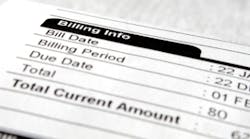The most effective time to send statements to dental patients
Many dental offices have a set monthly schedule for sending out their billing statements. Here are some reasons why this is not always the best way to handle the billing in your practice, and what is recommended instead.
This article originally appeared in Dental Assisting & Office Manager Digest. Subscribe to the monthly e-newsletter here.
Outstanding accounts receivable is not ideal in any business. The intention is to get paid for the service or product at the time it is rendered. For dental offices, this means having patients pay in full either prior to or on the day of service. But that’s usually not the case unless your office does not take assignment of benefits, because insurance companies need to receive the claims to pay their portions of the completed treatment.
The next best thing for dental offices is to have patients pay 100% of their portion before or on the day of service, and then submit the claim to the insurance company immediately. This way an office receives the remainder of what is due from the insurance company relatively quickly.
But no matter how hard you try to make either scenario a reality, things happens differently—the insurance estimates are incorrect and insurance pays less, resulting in remaining balances for patients to pay. Then your office has to follow up with patients to collect that balance. Most dental offices do that by sending statements to patients, outlining what was paid by insurance and what their remaining balances are.
Since we cannot entirely avoid having to send “balance due” statements to patients, it’s important to consider the best time to send statements. Many businesses send statements on a set day of each month. This feels right because processing statements can be time-consuming. Establishing a set time for running statements is a good way to ensure that they’re sent out. Many dental offices follow this billing philosophy, and this is understandable. The one thing we don’t have an excess of at the front desk of a dental office is “extra time.” So, sending statements on one day of the month might sound like a good solution.
I suggest NOT sending statements on a set day of the month.
4 reasons you should not set a statement schedule in your office
1. The sooner patients receive the bill, the better your chances of getting paid.
When a procedure is complete, the first thing a dental office normally does is submit its claim to the insurance company as quickly as possible. Once the insurance company processes the claim, the EOB is sent to the dental office and a copy goes to the patient. The patient likely opens the EOB, looks over it briefly, files it away, and doesn’t think about it again.
Why is this a problem? Let’s say your office sends patient statements on the 15th of each month and patients received their EOBs from their insurance companies on the 20th of the previous month. This means nearly 25 days passed between patients seeing the initial EOB from the insurance company and the day they received your statement. They are not likely to remember the EOB they looked at almost a month ago that showed the insurance company paid less than the original estimate.
Since patients will not associate your statement bill with their dental procedure performed months ago, they will be less inclined to pay the bill for something that has become a distant memory. If you want to increase the likelihood of patients paying their bills, you must send the request for payment as soon as possible, preferably right after the procedure is complete and the EOB has been received. People are more likely to pay their dental bills when they can remember what they received in exchange for their money.
2. Patients have short memories and we don’t want to be the bad guys.
A key component of billing is ensuring that the recipient remembers the details on the EOB. It’s important that patients know their balance not because of any decision by the dental office, but because the insurance company did not pay what was expected. We want patients to see how insurance downgraded or changed something about expected coverage, and we want to make clear that the insurance company is the bad guy, not the dental office. If the statement comes weeks after the EOB, patients will probably be frustrated with the dental office instead of the insurance company, which results in a decreased chance of the office being paid for services in a timely manner.
3. It’s best to distribute payments and phone calls over the course of the month.
If all the statements are sent out one day of the month, all patients will receive their statements about the same time. Those who receive their statement and don’t have a problem with it will send in their payment, which is great, but this results in a spike in collections during one week of the month. I prefer a steady flow of payments coming in throughout the month. More importantly, those who receive their statements and don’t remember how the unexpected amount relates to their EOB will call the office with questions or objections. If all the statements go out on one day, this means there will be an increased number of calls coming into the office to discuss balances over a period of just a few days.
Even though it seems to make sense from an efficiency standpoint to do all the billing once or twice a month, the reality is that reactions from patients are going to interrupt the functionality of your office. Any time you save on the billing end is going to be lost again (and then some) by a flood of billing-related calls after each statement mailing.
4. Sending out daily statements is much easier than it used to be.
Back in the dark ages when we had to print, address, stamp, and mail each statement, it was a real pain to handle statement processing. Times have changed and we can let technology do the heavy lifting. If you are using your practice management software to its full potential, it should not be time consuming or difficult to process statements. Once you receive the insurance EOB and enter the insurance payments, it’s as easy as the click of a button to send the patient statements. It doesn’t add any time to the process and will increase your chances of receiving payment from patients in a timely manner, and decrease the chances of the dreaded phone calls to discuss why their account has a balance.
Remember, the best scenario is to collect balances up front, but that isn’t always possible. When you need to collect balances from patients by sending statements, you’ll see better results and higher collection success by sending the statements as soon as possible rather than waiting for a “convenient” billing date.
Remember, your idea about what is inconvenient is probably based on the old methods of billing, before practice management software could handle most of the work for you. When your staff is well-trained on the use of the office’s software, you’ll find that sending statements more frequently is better for everyone and everything, including your bottom line.
For more information about how you can increase the revenue in your office, visit frontofficerocks.com.
For the most current office manager headlines, click here.
For the most current dental headlines, click here.
About the Author

Laura Nelson, MS, FAADOM
Founder of Front Office Rocks
Laura Nelson, MS, FAADOM, is the founder of Front Office Rocks, which provides an online training platform that delivers 24/7 educational resources, focusing on improving team efficiency and customer satisfaction. Laura cofounded Sober Life Rocks, which encourages sober choices at industry events. She wrote two books, Step Away from the Drill and Hiring without Hesitation, which share her strategies for excellence in practice management. Laura’s presentations and dedication to her field make her an inspiring speaker at dental conferences and seminars.
Updated April 29, 2024

